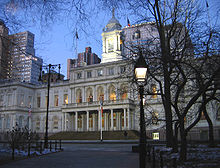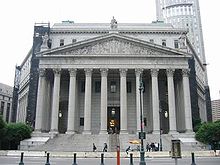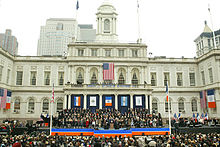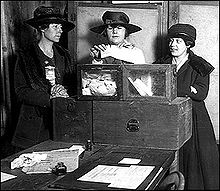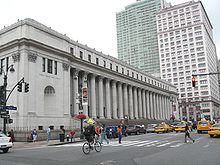- Government of New York City
-
The government of New York City is organized under the City Charter and provides for a "strong" mayor-council system. The government of New York is more centralized than that of most other U.S. cities, with the city government being responsible for public education, correctional institutions, libraries, public safety, recreational facilities, sanitation, water supply, and welfare services.[1]
The mayor is elected to a four-year term and is responsible for the administration of city government. The New York City Council is a unicameral body consisting of 51 members, each elected from a geographic district, normally for four year terms.
New York City's political geography is unusual. It is made up of five boroughs, each coterminous with one of five counties of New York State. Manhattan is New York County, Queens is Queens County, Brooklyn is Kings County, The Bronx is Bronx County and Staten Island is Richmond County. When New York City was consolidated into its present form in 1898, all previous local governments were abolished and replaced with the current unified, centralized city government. However, each county retains its own district attorney to prosecute crimes, and most of the court system is organized around the counties.
Contents
Executive branch
 Mayor Michael Bloomberg visiting with Grand Rabbi Moshe Leib Rabinovich of the Munkacs Hasidic sect in Brooklyn.
Mayor Michael Bloomberg visiting with Grand Rabbi Moshe Leib Rabinovich of the Munkacs Hasidic sect in Brooklyn.
The Executive branch of New York City consists of the Mayor, the Public Advocate, the Comptroller, and five Borough Presidents.[1] The heads of about 50 city departments are appointed by the mayor. The mayor also appoints several Deputy Mayors to head major offices within the executive branch of the city government. Deputy Mayors report directly to the Mayor.[1]
Mayor
The Mayor is responsible for all city services, police and fire protection, enforcement of all city and state laws within the city, and administration of public property and most public agencies.[1] The mayor is directly elected by popular vote for a four-year term, and formerly faced a two-term limit. Recent legislation increased the limit to three terms.[2]
The current mayor is Michael Bloomberg, a former Democrat elected as a Republican in 2001 with 50.3% of the vote and re-elected as a Republican in 2005 with 58.4%. Bloomberg left the Republican Party in 2007 and is now a political independent. In 2009, as an independent supported by the Republican Party, he was elected to third term with 50.7% of the vote. He is known for restructuring the governance of the city school system, rezoning and economic development initiatives, and public health initiatives such as banning smoking in bars and restaurants and making New York the first city in the United States to ban trans-fat from all restaurants.[3] In his second term, Bloomberg has made school reform, strict gun control, and poverty reduction central priorities of his administration. He is a founder of the Mayors Against Illegal Guns Coalition.[citation needed]
Public Advocate
The Public Advocate is a directly elected executive official and heads the Office of the Public Advocate. The Public Advocate's primary responsibility is to ease public relations with the government, investigate complaints regarding city agencies, mediate disputes between city agencies and citizens, serve as the city's ombudsman and advise the mayor on community relations. The Public Advocate is an ex-officio member of all Council committees and is permitted to introduce legislation in the Council[citation needed].
A holdover from what was City Council President, the position of Public Advocate has little real enforceable authority.
The Public Advocate stands first in line of succession to the mayoralty in the event of inability or incapacity of the mayor to continue in office, until a new election can be held.
The current Public Advocate is Bill de Blasio, a Democrat. He was elected in 2009 to serve a four-year term until 2013. He succeeded Betsy Gotbaum , another Democrat, who was elected in November 2001, and reelected in 2005.
Comptroller
The Comptroller is the city's chief financial officer, elected directly by city voters. In addition to managing the city's $80 billion pension fund, the Comptroller advises the mayor and the City Council on all financial matters, fiscal policy and financial transactions. The Office of the Comptroller is empowered with limited investigational power over all city expenditures and finance, and is responsible for auditing the finances of all city agencies. The Comptroller is a trustee on four of the five New York City pension funds, and serves as investment advisor to all five, representing $80 billion of assets, meaning s/he is responsible for managing the assets of the pension funds. The Comptroller also has responsibility for issuing and marketing all city bonds.
The Comptroller stands second, after the Public Advocate, in the line to succeed a mayor who has become unable to serve.
The current Comptroller is John Liu, a Democrat. He is the first Asian American to hold a city-wide office in New York City. He succeeded William C. Thompson, Jr., another Democrat who was elected in 2001 and re-elected in 2005. In the November 2009 elections, Thompson ran unsuccessfully for Mayor (rather than re-election as Comptroller), and Liu was elected to succeed him for the four-year term that began in January 2010.
Further information: New York City Comptroller election, 2009 and New York City mayoral election, 2009Borough Presidents
The five boroughs are coterminous with their respective counties, but the counties do not have actual county governments. Each borough elects a Borough President by direct popular vote. Under the current city charter, the Borough President's powers are limited. (The last significant power of the borough presidents—to appoint a member of the Board of Education—was abolished, along with the Board, on June 30, 2002.)
Borough presidents advise the Mayor on issues relating to each borough, comment on all land use items in their borough, advocate borough needs in the annual municipal budget process, administer a small discretionary budget for projects within each borough, appoint Community Boards, and chair the Borough Boards.
Government departments
- the Aging
- Buildings
- City Planning
- Citywide Administrative Services
- Consumer Affairs
- Correction
- Cultural Affairs
- Design & Construction
- Education
- Environmental Protection
- Finance
- Fire
- Health & Mental Hygiene
- Homelessness Services
- Housing Preservation and Development
- Human Resources
- Information Technology & Telecommunications
- Investigation
- Juvenile Justice
- Police
- Probation
- Law
- Parks & Recreation
- Records and Information Services
- Sanitation
- Small Business Services
- Transportation
- Youth & Community Development
Legislative branch
Legislative power in the City of New York is vested in the New York City Council. Bills passed by a simple majority are sent to the mayor, who may sign them into law. If the mayor vetoes a bill, the Council has 30 days to override the veto by a two-thirds majority vote.
The Council is a unicameral body consisting of 51 Council members, whose districts are defined by geographic population boundaries that each contain approximately 157,000 people. Council members are elected every four years, except that after every census held in years divisible by twenty, districts are redrawn, requiring two consecutive two-year terms, the second of which is held in the redrawn districts.
The Speaker of the Council, selected by the 51 Council members, is often considered the second most powerful post in New York City's government after the Mayor. The current Speaker is Democrat Christine Quinn, the first woman and first openly gay person to hold the position.
The Council has several committees with oversight of various functions of the city government. Each council member sits on at least three standing, select or subcommittees. The standing committees meet at least once per month. The Speaker of the Council, the Majority Leader, and the Minority Leader are all ex officio members of every committee.
Judicial branch
New York's court system is very complex, and contains vestiges of long-forgotten jurisdictions.
The courts are creatures of the State government. The court of basic general jurisdiction is State Supreme Court, which hears felonies and major misdemeanors, significant lawsuits, and governmental and elections matters. The court is divided into judicial districts and exists independently of the City government. Supreme Court Judges are elected.
Surrogate's Court handles probate and guardianship matters. It is a county court and also exists independently from the City. Surrogates are elected, two each from Manhattan and Brooklyn, one each from the other three boroughs.
New York City itself is responsible for civil, criminal, and family court systems. All have a presence in each borough and have city-wide jurisdiction.
The New York City Civil Court handles all small claims cases (up to $5,000) and all civil cases in the city with a monetary value up to $25,000, as well as residential and commercial landlord-tenant disputes. Judges of the Civil Court are elected to 10 year terms in either borough-wide or district elections.
The New York City Criminal Court is the beginning level trial court of criminal cases in the city. The court handles arraignments, misdemeanors, and minor felony cases. Criminal motions are also handled in this court, along with some jury trials. Major felony cases are referred to the New York State Supreme Court. Judges of the Criminal Court are appointed by the Mayor to 10 year terms.
The New York City Family Court hears matters involving children and families. Its jurisdiction includes custody and visitation, support, family offense (domestic violence), persons in need of supervision, delinquency, child protective proceedings (abuse and neglect), foster care approval and review, termination of parental rights, adoption and guardianship. Judges of the Family Court are appointed by the Mayor to 10 year terms. Justice Jane Bolin became the first black female judge in the United States when Mayor Fiorello La Guardia swore her in to the bench of the Family Court, then called the Domestic Relations Court, in 1939.
The Red Hook Community Justice Center in Brooklyn opened in 2000 as the nation's first multi-jurisdictional community court. Built to alleviate the chronic lack of access to justice services in the isolated Red Hook area, the court combines family court, civil and housing court and minor criminal court functions and takes a community development approach to justice through such programs as the Youth Court where teenagers are trained and act as mediators to help their peers resolve disputes.
Community Boards
- See also Bronx Community Boards, Brooklyn Community Boards, Manhattan Community Boards, Queens Community Boards, Staten Island Community Boards
New York City is divided into 59 administrative districts, each served by a Community Board. Community Boards are local representative bodies that serve as advocates for New York City residents and communities. Each Board has up to 50 voting members, with one half of the membership appointed each year for two-year terms; there are no term limits. Additionally, all city council members whose council districts cover part of a community district are non-voting, ex-officio Board members. Borough Presidents appoint the voting Community Board members, with half of the appointees nominated by council members representing the district.
Other features
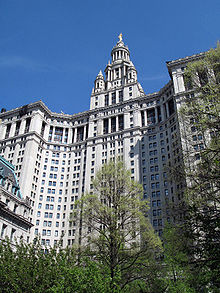 The Municipal Building, home to many city agencies, is one of the largest government office buildings in the world.
The Municipal Building, home to many city agencies, is one of the largest government office buildings in the world.
City budget
The New York City government's budget is the largest municipal budget in the United States. The city government spends about $61 billion a year, employs 250,000 people, spends $21 billion to educate more than 1.1 million children, levies $27 billion in taxes, and receives $14 billion from federal and state governments. New York State has more than 4,200 local governments in the form of counties, cities, towns, and villages. About 52% of all revenue raised by local governments in the state is raised solely by the government of New York City, which spends it on education (31%), social services (20%), public safety (13%), and benefits and pensions (10%).[4] New York City property taxes are lower than those in the suburbs because most of the city's revenue comes from income and sales taxes.
The city has a strong imbalance of payments with the federal and state governments. New York City receives 83 cents in services for every $1 it sends to Washington in taxes (or annually sends $13.1 billion more to Washington than it receives back). The city also sends an additional $11.1 billion more each year to the state of New York than it receives back.[5] The city's total tax burden is among the highest in the United States.[6]
Term limits and campaign finance
A two-term limit was imposed on City Council members and citywide elected officials after a 1993 referendum.[7] In 1996, voters turned down a City Council proposal to extend term limits. The movement to introduce term limits was led by Ronald Lauder, a cosmetics heir, who spent $4 million on the two referendums.
In 2008 the City Council voted 29-22 to overturn these two referendums and to extend the term limitation to three terms.[2][8]
New York has what is widely regarded as one of the most effective municipal campaign finance systems in the United States. The New York City Campaign Finance Board was created in 1988 in the wake of several political corruption scandals. It gives public matching funds to qualifying candidates, who in exchange submit to strict contribution and spending limits and a full audit of their finances. Citywide candidates in the program are required to take part in debates. Corporate contributions are banned and political action committees must register with the city.
3-1-1
Since March 2003 New York City has operated a single 24-hour phone number for government information and non-emergency services. The number, 3-1-1, is toll-free from any phone in the city. The services provided by 3-1-1 have gradually expanded since its start, including information on hundreds of City services, agencies, and events. New Yorkers call 3-1-1 for recycling schedules, complaints about garbage pick-up, street parking rules, noise complaints, landlord disputes and information about health insurance, information relating to recreation centers, public pools, golf courses and other facilities, or to schedule inspections by the Department of Buildings. 3-1-1 is also used by city agencies to direct resources and improve management. Outside of New York City, 3-1-1 can be accessed by calling (212) NEW-YORK (212-639-9675).
Between 2003 and 2006 3-1-1 received more than 30 million calls. Services are provided in over 170 languages, and calls are taken at a large, modern call center in Manhattan.[9] On December 20, 2005, the first day of the 2005 New York City transit strike, 3-1-1 received over 240,000 phone calls, setting a new daily record for the city.[10]
The proactive Street Conditions Observation Unit, or "Scout", was announced on August 16, 2007. The fifteen inspectors were drawn from five city agencies: environmental protection, transportation, sanitation, buildings, and housing preservation and development. They will roam the streets in three-wheel vehicles, reporting problems such as potholes and graffiti.[11]
Political culture
The Democratic Party holds the majority of public offices. Sixty-six percent of registered voters in the city are Democrats.[12] The only significant pockets of Republican strength are in Staten Island, as well as wealthier sections of Brooklyn and Queens.
New York City has not been won by a Republican in a Presidential or statewide election since 1924. This is in contrast to New York state as a whole, which is somewhat less liberal (though it has trended Democratic in most recent elections). However, Democrats currently have a supermajority in the New York State Assembly by virtue of holding all but two city-based districts. The Democrats are two seats short of a majority in the New York State Senate, holding all but two city-based districts.[citation needed]
Historically, the city's Republican officeholders have been considerably to the left of their national counterparts (with the significant exception of Staten Island). Labor and education politics are important. Housing and economic development are the most controversial topics, with an ongoing debate over the proposed Barclays Center. An ability to deal with the state government is also crucial, especially on matters of education funding.[citation needed]
The Working Families Party, affiliated with the labor movement and progressive community activists, is an important force in city politics. Party platforms are centered on affordable housing, education and economic development.[citation needed]
Mayor Michael Bloomberg has suggested the idea of nonpartisan elections for city offices, as many other cities use, but the idea currently has little support among other public officials.[citation needed]
New York City is split between 13 of the state's 29 congressional districts, all but one held by Democrats. The Democrats have been particularly dominant in the city's federal politics since the 1990s; even before then, Republicans only had a realistic chance at winning three of the city's districts. With former city councilman Michael McMahon's victory in the Staten Island-based 13th District, the Democrats took all of the city's congressional seats for the first time in 76 years. Due almost entirely to the Democrats' near-total dominance at the local level, the Democrats have held a majority of the state's congressional seats since the late 1950s.
Political influence
The Flushing Remonstrance signed by colonists in 1657 is considered a precursor to the United States Constitution's provision on freedom of religion in the Bill of Rights. The signers protested the Dutch colonial authorities’ persecution of Quakers in what is today the borough of Queens.
New York City politicians often exert influence outside the city in response to the city's diverse ethnic constituencies. For example, in 1984 the New York City Comptroller’s Office under the direction of then Comptroller Harrison J. Goldin developed with Irish Nobel Peace laureate Sean MacBride the MacBride Principles, which call on companies operating in Northern Ireland to increase employment opportunities for members of underrepresented religious groups, ban the display of provocative sectarian emblems in the workplace, promote security for minority employees and abolish hiring criteria that discriminate on the basis of religion or ethnicity. A 2006 report by the New York City Comptroller's Office found that 88 US and Canadian corporations operating in Northern Ireland had agreed to independent monitoring of their compliance with the MacBride Principles.[13]
Candidates running for parliament in countries like the Dominican Republic visit the large expatriate communities from their countries living in New York City to solicit donations and absentee votes. New York City mayors, in turn, visit these countries to build closer political and economic ties between the city and governments abroad.
Four of the top five zip codes in the United States for political contributions are in Manhattan. The top zip code, 10021 on the Upper East Side, generated the most money for the 2004 presidential campaigns of both George W. Bush and John Kerry.[14]
In 2008 New York City and London announced the Innovation Exchange Programme, in which the two cities will share best practices in government innovation. The program involves not only the formal exchange of ideas but also transfer of personnel between the cities. It will focus on transparency and accountability, efficiency, transport, policy, education and skills and environmental policy.[15]
As the international headquarters for the United Nations and its many associated institutions such as the UNFPA (United Nations Population Fund), New York is home to one of the world’s most important international institutions. It is also the headquarters of the Ford Foundation.
Suffrage
In the 1820s, New York State removed all property qualifications for the right to vote. Voting rights were extended to all white males, regardless of whether they owned or rented property. In 1846 voters in New York State rejected a proposed amendment to the state constitution that would guarantee free blacks the same voting rights as whites. In 1870, however, five years after the Civil War, the 15th Amendment to the U.S. Constitution was ratified, giving blacks throughout the United States the same voting rights as whites.
New York City introduced a uniform ballot listing all candidates in 1880. To get on it, an office seeker would have to be nominated by a political party or submit nominating petitions, laying the groundwork for a system that persists to this day. In 1894 bipartisan control of elections was introduced, establishing a system in effect to this day. All election positions, from Board of Elections commissioners to election inspectors, must be divided equally between the two major parties.
A voting machine developed by Jacob H. Myers, was used in Lockport, New York in 1892. By the early 1920s, voting machines would be used for all general elections in New York City.
A 1915 referendum giving women the vote was defeated by city and state voters, but in 1920 the 19th Amendment to the U.S. Constitution was signed into law, guaranteeing women throughout the United States the right to vote.
In 1967, a suit brought under the Voting Rights Act passed by the U.S. Congress two years earlier lead to the creation of the majority black 12th Congressional District in Brooklyn. Previously, black voters had been divided among several predominantly white districts. In 1968, voters in the district elected Shirley Chisholm as the first black woman ever in the U.S. House of Representatives. Since then, congressional, state legislative and City Council districts have been drawn so as to ensure minority representation.
Non-citizens who have children in public schools were given the right to vote in elections for members of community school boards in 1969 (those boards no longer exist). Starting in 1975 election information was provided in Spanish as well as English, and in 1992 the City introduced ballots in Chinese.
Official seal and flag
The seal of the City of New York, adopted in an earlier form in 1686, bears the legend SIGILLVM CIVITATIS NOVI EBORACI, which means simply "The Seal of the City of New York." Eboracum was the Roman name for York, the titular seat of James II as Duke of York. The two supporters represent the unity between Native American and colonist, the four windmill sails recall the city's Dutch history as New Amsterdam, and the beavers and flour barrels the city's earliest trade goods (see History of New York City). The crest over the seal is the American eagle added after the American Revolution. "1625," at the bottom, is the date of the founding of the city.
The flag of New York City was adopted in 1915. Its blue, white, and orange bands represent the colors of the Dutch flag that flew over the city, then New Amsterdam, between the 1620s and 1660s. Located in the center is a blue print of the official Seal of New York City.
The Mayor's Office has its own official flag as well, which is the same design with an added five-pointed star (representing each of the five boroughs) in blue.
Federal representation
The United States Post Office operates post offices in New York City. The James A. Farley Post Office in Midtown Manhattan is the city's main post office.[16] The post office stopped 24 hour service beginning on May 9, 2009 due to decreasing mail traffic.[17] Brooklyn, Bronx, and Staten Island each have central and/or main post offices.[18] Queens has three, each serving one of the former townships of Queens County.
New York City also has federal buildings in downtown Manhattan that house buildings for the United States Attorney and the FBI.
New York's military installations include the United States Army post of Fort Hamilton located in the Bay Ridge section of Brooklyn under the shadow of the Verrazano-Narrows Bridge. The bridge spans the Narrows and connects to Staten Island, where Coast Guard base Fort Wadsworth lies under the bridge's shadow. Fort Totten is another military installation located in Queens near the Throggs Neck Bridge.
See also
New York City-related articles:
- Tammany Hall
- Government and politics of the Bronx
- Government of Staten Island
- City of Greater New York
- History of New York City
- History of Brooklyn
- New York City mayoral elections
- New York Police Department
- Fire Department of New York
- New York City Department of Correction
New York State-related articles:
- Government of New York
- New York State public benefit corporations
- Elections in New York
- Politics of New York
- American Labor Party
- Conservative Party of New York
- Independence Party of New York
- Liberal Party of New York
- New York State Right to Life Party
- Working Families Party
References
- ^ a b c d "New York City Charter" (PDF). City of New York. July 2004. http://www.nyc.gov/html/charter/downloads/pdf/citycharter2004.pdf. Retrieved 2009-07-19.
- ^ a b Sewell Chan and Jonathan P. Hicks, Council Votes, 29 to 22, to Extend Term Limits, The New York Times, published on-line and retrieved on October 23, 2008
- ^ Dunlap, David W. (2004-01-01). "Blocks; Capturing the Spirit of 1776, but With a Different Number". New York Times. http://select.nytimes.com/gst/abstract.html?res=F40D16F83C550C728CDDA80894DC404482. Retrieved 2006-07-19.
- ^ Office of the New York State Comptroller (2006-11). "2006 Annual Report on Local Governments". http://www.osc.state.ny.us/localgov/datanstat/annreport/06annreport.pdf. Retrieved 2006-11-14.
- ^ New York City Finance Division (2005-03-11). "A Fair Share State Budget: Does Albany Play Fair with NYC?". http://webdocs.nyccouncil.info/attachments/65379.htm?CFID=232457&CFTOKEN=33008944. Retrieved 2006-07-19.
- ^ Chan, Sewell (2007-02-25). "Taxed: What Makes New York Different". The New York Times. http://www.nytimes.com/2007/02/25/weekinreview/25basicA.html. Retrieved 2007-02-28.
- ^ NY Times, November 3, 1993
- ^ Fernanda Santos: The Future of Term Limits Is in Court, The New York Times, New York edition, October 24, 2008, page A24 (retrieved on October 24, 2008), Judge Rejects Suit Over Term Limits, The New York Times, New York edition, January 14, 2009, page A26, and Appeals Court Upholds Term Limits Revision, The New York Times City Room Blog, April 28, 2009 (both retrieved on July 6, 2009). The original January decision by Judge Charles Sifton of the United States District Court for the Eastern District of New York (Long Island, Brooklyn, Queens and Staten Island) was upheld by a three-judge panel of the United States Court of Appeals for the Second Circuit (Vermont, Connecticut and New York state).
- ^ New York City Department of Information Technology and Telecommunications.[1]
- ^ Mayor Michael Bloomberg, Press Conference, 21 Dec 2005.
- ^ NY Times, August 17, 2007
- ^ New York State Board of Elections (2006-04-01). "County Enrollment Totals". http://www.elections.state.ny.us/NYSBOE/enrollment/county/county_apr06.htm. Retrieved 2006-07-19.[dead link]
- ^ Office of the New York City Comptroller (2006-11). "The MacBride Principles and Fair Employment Practices in Northern Ireland". Archived from the original on 2006-11-30. http://web.archive.org/web/20061130204137/http://www.comptroller.nyc.gov/press/pdfs/pr-06-11-084_macbride_principles.pdf. Retrieved 2006-11-14.
- ^ Opensecrets.org (2005-05-16). "2006 Election Overview: Top Zip codes". http://www.opensecrets.org/bigpicture/topzips.asp?cycle=2004. Retrieved 2006-07-19.
- ^ The London New York Dialogue (2008-07). "London and New York in the 21 Century: can London and New York still be the Leading World Cities in 2100?". http://www.nysun.com/files/lny-june-19-08.pdf. Retrieved 2008-08-11.
- ^ "Post Office Location - JAMES A. FARLEY." United States Postal Service. Retrieved on May 5, 2009.
- ^ "New York City's main post office stops 24-hour service." Associated Press. Friday April 17, 2009. Retrieved on May 5, 2009.
- ^ "NYC Post Offices to observe Presidents’ Day." United States Postal Service. February 11, 2009. Retrieved on May 5, 2009.
External links
- New York City government
- New York City Charter
- Public access portal to the laws of New York City
- Map of New York City's political contributions
- Sister Cities
Government of New York City Officials ElectedAppointedIndependent organs Departments the Aging · Buildings · City Planning · Citywide Administrative Services · Consumer Affairs · Correction · Cultural Affairs · Design & Construction · Education · Environmental Protection · Finance · Fire · Health & Mental Hygiene · Homeless Services · Housing Preservation and Development · Information Technology & Telecommunications · Investigation · Juvenile Justice · Law · Parks & Recreation · Police · Probation · Records and Information Services · Sanitation · Small Business Services · Transportation · Youth & Community Development · Human ResourcesOther agencies Libraries Other services The Five Boroughs The Bronx (Bronx government) · Brooklyn · Manhattan · Queens · Staten Island (Staten Island government)Community BoardsNew York City History · Neighborhoods · Architecture · Skyscrapers · Tourism · Attractions · Culture · Books · Arts · Parks · Cuisine · Dialect · People · Music · Sports · Media · Economy · Companies · Education · Schools · Government · Mayor · Central Park · Council · Fire · Police · Landmarks · Crime · Elections · Geography · Harbor · Gardens · Flag · Environment · Demographics · Enclaves · Transportation · Hospitals · Lists · Images · Portal Categories:
Categories:
Wikimedia Foundation. 2010.

